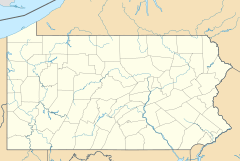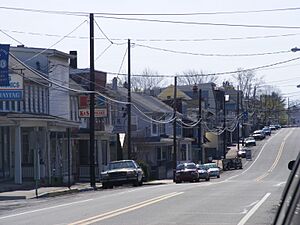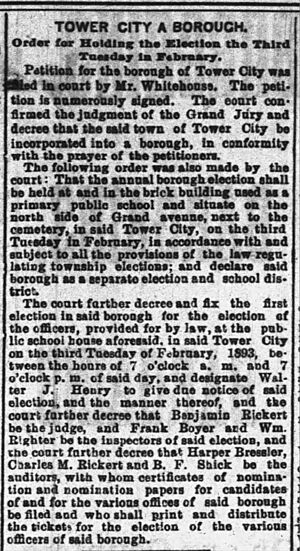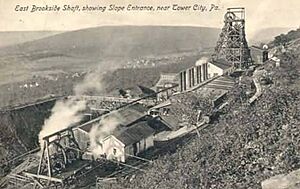Tower City, Pennsylvania facts for kids
Quick facts for kids
Tower City, Pennsylvania
|
|
|---|---|
|
Borough
|
|
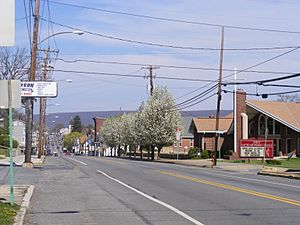
East Grand Avenue (Rt. 209), facing northeast
|
|

Location of Tower City in Schuylkill County, Pennsylvania.
|
|
| Country | United States |
| State | Pennsylvania |
| County | Schuylkill |
| Settled | 1868 |
| Incorporated | 1892 |
| Government | |
| • Type | Borough Council |
| Area | |
| • Total | 0.32 sq mi (0.81 km2) |
| • Land | 0.32 sq mi (0.81 km2) |
| • Water | 0.00 sq mi (0.00 km2) |
| Population
(2020)
|
|
| • Total | 1,419 |
| • Density | 4,504.76/sq mi (1,741.88/km2) |
| Time zone | UTC-5 (Eastern (EST)) |
| • Summer (DST) | UTC-4 (EDT) |
| Zip code |
17980
|
| Area code(s) | 717 |
| FIPS code | 42-77184 |
Tower City is a small town, called a borough, located in Schuylkill County, Pennsylvania, in the United States. In 2020, about 1,419 people lived there.
Contents
Where is Tower City?
Tower City is located at 40°35′20″N 76°33′12″W / 40.58889°N 76.55333°W. It covers a total area of about 0.3 square miles (0.8 square kilometers), and all of it is land.
How Many People Live Here?
| Historical population | |||
|---|---|---|---|
| Census | Pop. | %± | |
| 1890 | 2,053 | — | |
| 1900 | 2,167 | 5.6% | |
| 1910 | 2,325 | 7.3% | |
| 1920 | 2,324 | 0.0% | |
| 1930 | 2,482 | 6.8% | |
| 1940 | 2,221 | −10.5% | |
| 1950 | 2,054 | −7.5% | |
| 1960 | 1,968 | −4.2% | |
| 1970 | 1,774 | −9.9% | |
| 1980 | 1,667 | −6.0% | |
| 1990 | 1,518 | −8.9% | |
| 2000 | 1,396 | −8.0% | |
| 2010 | 1,346 | −3.6% | |
| 2020 | 1,424 | 5.8% | |
| 2021 (est.) | 1,427 | 6.0% | |
| U.S. Decennial Census | |||
In the year 2000, there were 1,396 people living in Tower City. These people lived in 608 households, and 383 of those were families. The town had about 4,547 people per square mile.
Most people in Tower City were White (98.85%). A small number were African American or from other backgrounds. About 0.86% of the population was Hispanic or Latino.
About 28.5% of households had children under 18 living with them. Almost half (47.2%) were married couples. About 19.9% of households had someone living alone who was 65 years old or older.
The average age in Tower City was 39 years old. About 23.7% of the people were under 18, and 20.2% were 65 or older.
Schools in Tower City
Tower City is part of the Williams Valley School District. This school district serves communities in both western Schuylkill County and eastern Dauphin County.
History of Tower City
How Tower City Began
Tower City was named after its founder, Charlemagne Tower. He was a lawyer from New York who came to Schuylkill County, Pennsylvania, in 1846. He worked on legal issues related to land that had large amounts of coal and other minerals.
Charlemagne Tower and his partner, Alfred Munson, secretly bought many pieces of land with coal deposits. Their goal was to create one very large piece of land. Tower used his legal skills to clear up any problems with who owned the land. He even used other people's names to hide who was really buying the land.
By 1858, Tower and Munson owned 11,000 acres (about 45 square kilometers) of land. Other people soon found out about their plan. Many lawsuits started over who owned the land. Tower's skills as a lawyer were very important to keep their plan from failing.
In 1867, Tower decided to sell the land. But he couldn't find a buyer because of all the ownership issues. So, he decided to start coal mines on the land instead. In March 1868, he leased 1,503 acres (about 6 square kilometers) to two coal companies. They built two mines: the Tower Colliery and the Brookside Colliery.
Near these mines, Tower started to develop a small town. It was named Tower City when it was first mapped out. Tower created the town layout and rented out lots to people who wanted to live there. The town was busy by mid-1872 and quickly needed more houses. As the coal mines grew, so did the town. Tower City officially became a borough on December 19, 1892.
The Coal Industry in Tower City
The Brookside Colliery started in 1868. It was run by different groups until 1873.
In the 1870s, Franklin Gowen, who was the President of the Reading Railroad, began buying coal lands. He wanted to control most of the anthracite coal mining. By 1875, Gowen had bought 70,000 acres (about 283 square kilometers) of land. Tower sold his lands to Gowen for $3 million. Tower made a profit of $1.5 million from this sale.
Later that year, the Philadelphia & Reading Coal & Iron Company took over the Brookside Colliery. This company was set up by the Reading Railroad to manage their coal properties. The Brookside Colliery closed in 1938. During its operation, it produced over 19 million tons of coal.
The Tower Colliery also started in 1868. It operated until 1874 and then closed. It produced about 101,550 tons of coal. The Philadelphia & Reading Coal & Iron Company reopened this mine in 1892. They renamed it the East Brookside and operated it along with the original Brookside, which became known as the West Brookside.
Train Service for Coal
The growing coal industry in Tower City first used the Good Spring Railroad. This railroad built a line to the Brookside mine in 1867. Over time, this railroad line became part of the Reading Railroad system.
In 1892, the Williams Valley Railroad began operating. It extended train service further west from Tower City. This railroad also came under the control of the Reading Company within a few years. Train service to Tower City ended in 1971.
Important Mine Accidents
The Brookside Explosion
On August 2, 1913, two explosions happened at the East Brookside Colliery. Eighteen men died, and two others were seriously hurt.
The explosions happened after the mine had stopped production for the day. Some workers were still inside cleaning up after blasting. The first explosion happened around noon. About 20 minutes later, a second explosion occurred.
It is thought that the first explosion might have been caused when a worker's shovel hit dynamite. The second explosion was likely caused by mine gases that were released by the first blast.
The Porter Tunnel Flood
On March 1, 1977, workers in the Porter Tunnel mine accidentally broke into an old, flooded mine area. This caused the Porter Tunnel to flood. Nine miners died, three were injured, and one miner was trapped but was later rescued.
Later investigations showed that the map used by the mine's management was not correct. It did not show all the old, abandoned mines in the area, including the one that flooded. Workers had said that a program to drill test holes for water had been stopped before the flood happened.
Images for kids
See also
 In Spanish: Tower City (Pensilvania) para niños
In Spanish: Tower City (Pensilvania) para niños


